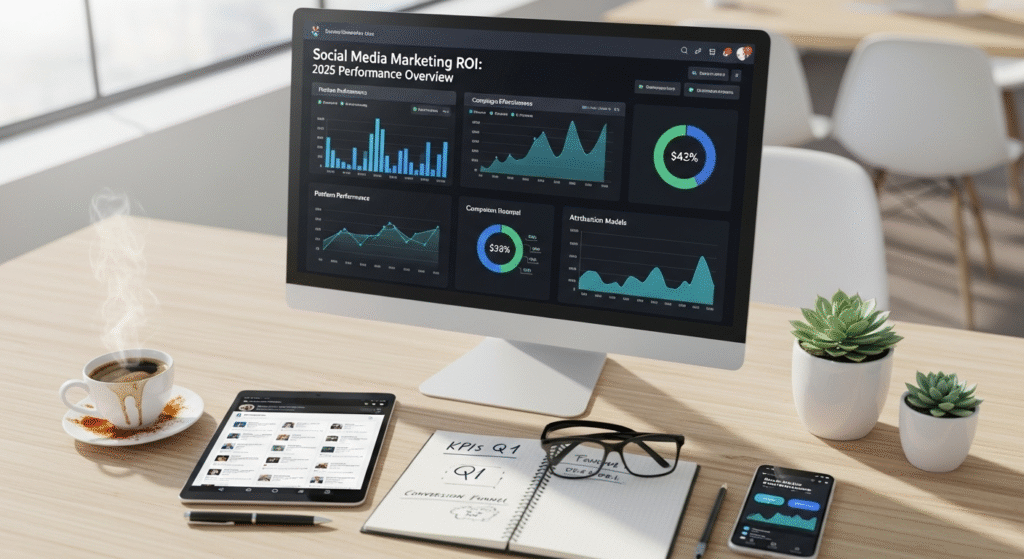Measuring social media ROI remains one of the biggest challenges for marketers, yet it’s essential for proving campaign value and securing budget approval. With the right metrics and tracking systems, you can demonstrate clear returns from your social media investments.
Why ROI Measurement Matters
Budget Justification: Clear ROI data helps secure ongoing marketing budgets and resource allocation from leadership teams.
Strategy Optimization: Understanding which campaigns deliver results allows you to double down on successful tactics and eliminate wasteful spending.
Competitive Advantage: Brands that measure ROI effectively can make faster, more informed decisions than competitors relying on vanity metrics.
Setting Up Proper ROI Tracking
Define Clear Objectives: Before launching campaigns, establish specific, measurable goals that align with business outcomes rather than social media metrics.
Attribution Models: Implement tracking systems that connect social media activities to actual business results like sales, leads, or sign-ups.
UTM Parameters: Use unique tracking codes on all social media links to identify which platforms and campaigns drive website traffic and conversions.
Conversion Tracking: Set up pixel tracking and conversion events across platforms to monitor user actions after clicking social media content.
Key ROI Metrics That Matter
Revenue Attribution: Track direct sales generated from social media campaigns using e-commerce tracking and customer journey analysis.
Cost Per Acquisition (CPA): Calculate how much you spend on social media to acquire each new customer, comparing this to customer lifetime value.
Lead Generation Value: Assign monetary values to leads based on your typical conversion rates and average deal sizes.
Brand Awareness Lift: Measure increases in brand searches, direct website traffic, and unattributed sales during campaign periods.
Customer Retention Impact: Track how social media engagement affects customer loyalty, repeat purchases, and lifetime value.
Platform-Specific ROI Calculation
Instagram ROI:
Track Story swipe-ups and bio link clicks
Monitor Instagram Shop purchases and product discovery
Measure influencer partnership performance through unique discount codes
TikTok ROI:
Analyze website traffic spikes following viral content
Track hashtag challenge participation and user-generated content
Monitor brand mention increases and sentiment improvements
Linkedln ROI:
Calculate lead quality and conversion rates from Linkedln campaigns
Track B2B sales pipeline development from social selling activities
Measure thought leadership impact on business development
Tools for ROI Measurement
Native Platform Analytics: Use built-in analytics from Facebook, Instagram, Linkedln, and TikTok for basic performance tracking.
Google Analytics 4: Connect social media traffic to website conversions and e-commerce data for comprehensive attribution.
CRM Integration: Link social media leads to your customer relationship management system to track long-term value.
Attribution Software: Invest in specialized tools that provide multi-touch attribution across marketing channels.
Common ROI Calculation Mistakes
Focusing on Vanity Metrics: Likes, followers, and impressions don’t directly correlate to business value without conversion tracking.
Ignoring Assisted Conversions: Social media often influences customers who convert through other channels, requiring multi-touch attribution.
Short-Term Thinking: Brand awareness and relationship building create long-term value that may not show immediate ROI.
Incomplete Cost Calculation: Include staff time, content creation costs, and tool subscriptions in your total investment calculations.
Advanced ROI Strategies
Lifetime Value Analysis: Calculate the long-term worth of customers acquired through social media to justify higher acquisition costs.
Cross-Platform Attribution: Understand how different social platforms work together in the customer journey rather than analyzing them in isolation.
Sentiment Value: Assign monetary value to positive brand sentiment improvements and reputation management benefits.
Competitive Intelligence: Monitor competitor social media performance to benchmark your ROI against industry standards.
ROI Reporting Best Practices
Executive Dashboards: Create simple, visual reports that clearly communicate ROI to leadership without overwhelming technical details.
Regular Review Cycles: Establish monthly or quarterly ROI reviews to identify trends and optimization opportunities.
Campaign Comparisons: Compare ROI across different campaign types, platforms, and time periods to identify best practices.
Benchmark Setting: Establish realistic ROI expectations based on industry standards and your historical performance.
Budget Allocation: Shift spending toward platforms and content types that deliver the highest returns based on your measurement data.
Maximizing Social Media ROI
Content Optimization: Focus on content formats and topics that drive the most valuable actions from your audience.
Audience Refinement: Use ROI data to identify your most profitable customer segments and target them more precisely.
Testing Framework: Implement systematic A/B testing to continuously improve campaign performance and ROI.
Conclusion
Measuring social media ROI requires moving beyond surface-level metrics to track real business impact. The key is establishing clear objectives, implementing proper tracking systems, and analyzing data that connects social media activities to revenue outcomes.
Success comes from consistent measurement, continuous optimization, and clear communication of results to stakeholders. Brands that master ROI measurement can justify larger social media investments and achieve sustainable competitive advantages through data-driven decision making.

